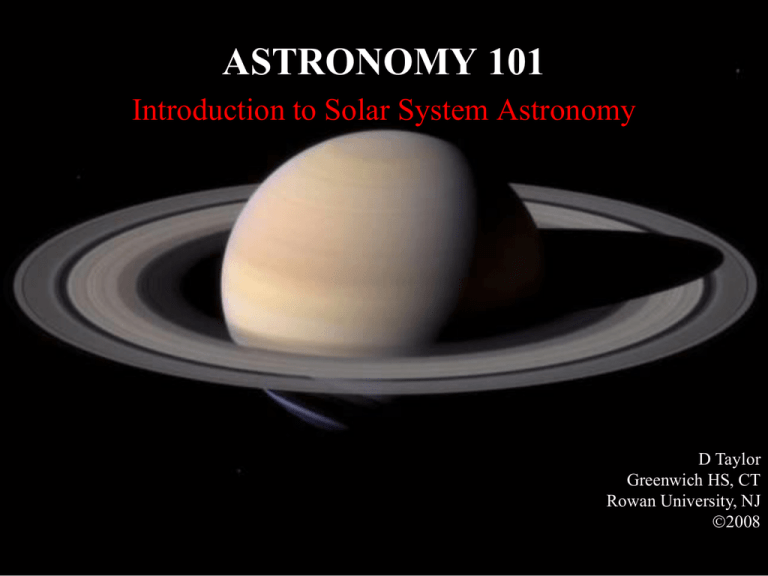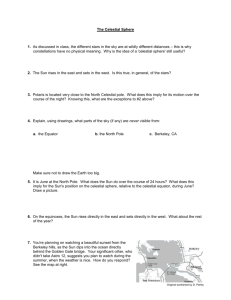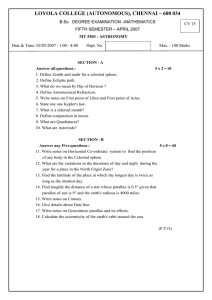ASTRONOMY 101 Introduction to Solar System Astronomy D Taylor Greenwich HS, CT
advertisement

ASTRONOMY 101 Introduction to Solar System Astronomy D Taylor Greenwich HS, CT Rowan University, NJ 2008 Astronomy 2008: The Web Page www.DTFizzix.com Astronomy Picture of the Day (APOD): http://antwrp.gsfc.nasa.gov/apod/ The Celestial Sphere Thursday, September 11 The Celestial Sphere: Key Concepts (1) The sky as seen from Earth is divided into 88 constellations. (2) It is convenient to pretend the stars are attached to a celestial sphere. (3) The celestial sphere appears to rotate about the celestial poles (1 day). (4) The Sun appears to move west to east relative to stars (1 year). (5) The Moon appears to move west to east relative to stars (1 month). (1) The sky is divided into 88 constellations Mesopotamia, circa 3000 BC: oldest know constellations Ptolemy, 2nd century AD: 48 constellations in northern sky 16th to 18th century AD: unmapped regions of sky filled in Constellations are largely arbitrary Other cultures, other constellations: Example: Ursa Major = bear, dipper, bull's leg, grain scoop, wagon, plow, etc. Stars in a constellation usually are not at the same distance from us. At a different place in our Galaxy, we would see different star patterns. A modern star chart of Ursa Major: (2) Stars are “attached” to a celestial sphere Distances to stars are hard to measure. However, we can pretend all stars are at the same distance from us, attached to a large celestial sphere. Position on the celestial sphere is known even when the distance in unknown. Celestial Sphere: A large imaginary sphere centered on Earth Special locations on the celestial sphere North Celestial Pole = point directly above Earth’s North Pole (near the star Polaris) South Celestial Pole = point directly above Earth’s South Pole (no nearby bright star) Celestial Equator = circle directly above Earth’s Equator Distances between points on the celestial sphere are measured in degrees, arcminutes, and arcseconds 360 degrees in a circle 60 arcminutes in a degree 60 arcseconds in an arcminute ½ degree = angular size of Sun & Moon Celestial navigation made simple At Earth’s North Pole: Polaris is directly overhead At Earth’s Equator: Polaris is due north, on the horizon In Earth’s Northern hemisphere: Polaris is due north - height above the horizon (in degrees) is equal to your latitude (in degrees) (3) The celestial sphere appears to rotate about the celestial poles (1 day cycle) Observation: Stars, Sun, Moon and planets move in counterclockwise circles around north (south) celestial pole. Objects near the celestial equator move east to west when above the horizon (“rising” in east, “setting” in west). What causes these circular motions? Explanations of the 1 day cycle: HYPOTHESIS #1 HYPOTHESIS #2 (Ptolemy, 2nd century): (Copernicus, 16th cent.): Earth is stationary; stars Stars are stationary; Earth are attached to a sphere rotates about its axis that revolves around once per day. the Earth once per day. RIGHT! WRONG! Nicolaus Copernicus (1473-1543) Foucault's Pendulum Linkicus (4) The Sun appears to move west to east relative to stars (1 year cycle) Today the Sun is “in” Sagittarius, next month in Capricornus, etc. Sun’s path on the celestial sphere = ecliptic Constellations through which the ecliptic runs = zodiac The ecliptic is NOT the same as the celestial equator! Observation: Sun moves west to east relative to stars (about 1 degree per day). What causes this annual motion? Explanations of 1 year cycle: HYPOTHESIS #1 (Ptolemy): Sun revolves around Earth at a slightly slower rate than the celestial sphere. WRONG! HYPOTHESIS #2 (Copernicus): Earth revolves around the Sun, once per year. RIGHT! (5) The Moon appears to move west to east relative to stars (1 month cycle) Today the Moon is “in” Scorpius In two weeks: Gemini In four weeks: Scorpius, again. Observation: Moon moves west to east relative to stars, taking 27.3 days to complete cycle. What causes this monthly motion? Explanations of 1 month cycle: HYPOTHESIS #1 (Ptolemy): Moon revolves around Earth at a significantly slower rate than the celestial sphere. WRONG! HYPOTHESIS #2 (Copernicus): Moon revolves around Earth, once per month. RIGHT! Few closing questions: 1) Can the Sun come close to the North Celestial Pole? 2) Can the Moon come close to the South Celestial Pole? 3) You are on the Earth’s equator---how high is Polaris above the horizon? 4) How often does the Sun cross the plane of the ecliptic? Few closing questions continued: 5) How often does the Moon cross the plane of the ecliptic? 6) How often does the Sun cross the Celestial Equator? 7) How often does the Moon cross the Celestial Equator? NEW TEXTBOOK?????


